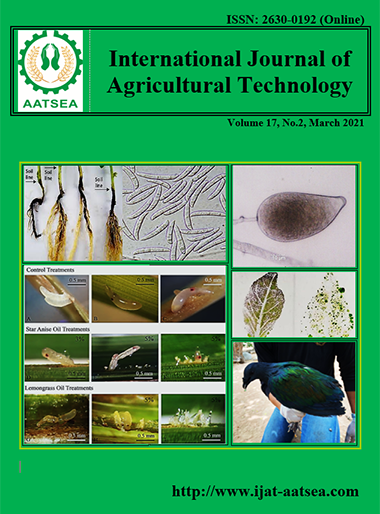Synthesis of new metal complex dye and its application on nylon fibers pretreated with chitosan
Main Article Content
Abstract
The concept of preparing new metal complex dyes is vital and indispensable for improving the dyeing properties of the fiber, especially it has been previously treated with a natural product as chitosan. Our present investigation found to synthesize and application of new metal complex dye based on acid dye and the structures of the investigated compound which was confirmed by spectroscopic techniques. The dye is applied to nylon fibers pretreated with chitosan by the conventional method. The absorbance of the original and residual dye in the dye bath was calculated from dye exhaustion. Color measurements and fastness properties of washing, rubbing, perspiration, and the light were performed on the dyeing produced on nylon fibers
Article Details

This work is licensed under a Creative Commons Attribution-NonCommercial-NoDerivatives 4.0 International License.
References
Adachi, M., Bredow, T. and Jug, K. (2004). What is the origin of color on metal complex dyes? Theoretical analysis of a Ni-coordinate azo dye. Dyes and Pigments, 63:225-230.
Ali N, F., EL-Khatib, E. M. and Saadia A. Abd El-Megied (2019). Modification of wool and silk fibers by pretreatment with Quaternary ammonium salt and dyeing with new metal complex dye. World Journal of Pharmaceutical and life sciences, 5:73-79.
Ali, N. F. and Abd-Elsalam, I. S. (2020). Antimicrobial characteristics of wool fibers treated with chitosan-propolis nano composite and dyed with natural dye extracted from Red Prickly Pear. International Journal of Agricultural Technology, 16:223-236.
Amin, A. S. and Mohammed, T. Y. (2001). Simultaneous spectrophotometric determination of thorium and rare earth metals with pyrimidine azo dyes and cetylpyridinium chloride. Talanta, 54:611-620.
Broadbent, A. D. (2001). Chapter 4, Synthetic fibers. In: Basic Principles of Textile Coloration, England, Society of Dyers and Colourists, pp.50-69.
Dharmalingam, V., Ramasamy, K. and Balasuramanian, V. (2011). Synthesis and EPR Studies of Copper Metal Complexes of Dyes Derived from Remazol Red B, Procino Yellow, Fast Green FCF, Brilliant Cresyl Blue with Copper Acetate Monohydrate. E-Journal of Chemistry, 8:211-244.
Hameed, S. A. (2007). Characterization and Thermal Decomposition of Indolylidene Aniline Azo-Dyes Derivatives. Jordan Journal of Chemistry, 2:133-144.
Judd, D. B. and Wysezcki, G. (1975). Colour in Business, Science, and Industry. 3rd Ed., NewYork: John Wiley & Sons.
Kirkan, B. and Gup, R. (2008). Synthesis of new azo dyes and copper (II) complexes derived fromBarbituric acid and 4-aminobenzoilhydrazone. Turkish Journal of Chemistry, 32:9-17.
Maria, F., Ioannis, E., Nikolaidis Nikolaos, N. and Eforia, T. (2014). Synthesis, characterization and application of anionic metal complex azo dyes as potential substitutes for Cr-complex dyes. Textile Research Journal, 84:2036-2044.
Mohamed, F. A., Saadia A. Abd El-Megiedand and Mohare b, R. M. (2020). Synthesis and Application of Novel Reactive Dyes Based on DimedoneMoiety. Egyptian Journal of Chemistry, 63:4447-4455.
Otutu, J. O. (2011). Synthesis of some new disperse dyes derived from N-phenyl Naphthylamine. Oriental Journal of Chemistry, 27:1011.
Özacar, M. and Şengil, I. A. (2005). Adsorption of metal complex dyes from aqueous solutions by pine sawdust. Bioresource Technology, 96:791-795.
Shawali, A. S. and Mosselhi, M. A. N. (2003). Hydrazonoyl halides: useful building blocks for the synthesis of arylazoheterocycles. Journal of Heterocyclic Chemistry, 40:725-746.
Woisetschläger, O. E., Sünkel, K., Weigand, W. and Beck W. (1999). Metal complexes of biologically important ligands, CXVI. Addition of carbanions from barbituric acid derivatives to unsaturated hydrocarbons in cationic complexes for the organometallic labelling of barbituric acid. Journal of Organometallic Chemistry, 584:122-130.
Yildiz, E. and Boztepe, H. (2002). Synthesis of novel acidic mono azo dyes and an investigation of their use in the Textile Industry. Turkish Journal of Chemistry, 26:897-903.
Zhang, H. and Wang, L. L. (2010). Study on the properties of woolen fabric treated with chitosan/TiO2 sol. Journal of the Textile Institute, 101:842-848.


